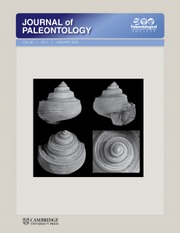Crossref Citations
This article has been cited by the following publications. This list is generated based on data provided by
Crossref.
Wan, Bin
Xiao, Shuhai
Yuan, Xunlai
Chen, Zhe
Pang, Ke
Tang, Qing
Guan, Chengguo
and
Maisano, Jessica A.
2014.
Orbisiana linearis from the early Ediacaran Lantian Formation of South China and its taphonomic and ecological implications.
Precambrian Research,
Vol. 255,
Issue. ,
p.
266.
Van Iten, Heyo
Marques, Antonio C.
Leme, Juliana de Moraes
Pacheco, Mirian L. A. Forancelli
Simões, Marcello Guimaraes
and
Smith, Andrew
2014.
Origin and early diversification of the phylum Cnidaria Verrill: major developments in the analysis of the taxon's Proterozoic–Cambrian history.
Palaeontology,
Vol. 57,
Issue. 4,
p.
677.
Schiffbauer, James D.
and
Xiao, Shuhai
2014.
An Examination of Life History and Behavioral Evolution Across the Ediacaran–Cambrian Transition.
Journal of Paleontology,
Vol. 88,
Issue. 2,
p.
205.
Kolesnikov, Anton V.
Marusin, Vasiliy V.
Nagovitsin, Konstantin E.
Maslov, Andrey V.
and
Grazhdankin, Dmitriy V.
2015.
Ediacaran biota in the aftermath of the Kotlinian Crisis: Asha Group of the South Urals.
Precambrian Research,
Vol. 263,
Issue. ,
p.
59.
Liu, Alexander G.
Kenchington, Charlotte G.
and
Mitchell, Emily G.
2015.
Remarkable insights into the paleoecology of the Avalonian Ediacaran macrobiota.
Gondwana Research,
Vol. 27,
Issue. 4,
p.
1355.
Grazhdankin, D.V.
and
Maslov, A.V.
2015.
The room for the Vendian in the International Chronostratigraphic Chart.
Russian Geology and Geophysics,
Vol. 56,
Issue. 4,
p.
549.
Dzik, Jerzy
and
Martyshyn, Andrej
2015.
Taphonomy of the Ediacaran Podolimirus and associated dipleurozoans from the Vendian of Ukraine.
Precambrian Research,
Vol. 269,
Issue. ,
p.
139.
Burzynski, Greg
and
Narbonne, Guy M.
2015.
The discs of Avalon: Relating discoid fossils to frondose organisms in the Ediacaran of Newfoundland, Canada.
Palaeogeography, Palaeoclimatology, Palaeoecology,
Vol. 434,
Issue. ,
p.
34.
Rogov, V.I.
Karlova, G.A.
Marusin, V.V.
Kochnev, B.B.
Nagovitsin, K.E.
and
Grazhdankin, D.V.
2015.
Duration of the first biozone in the Siberian hypostratotype of the Vendian.
Russian Geology and Geophysics,
Vol. 56,
Issue. 4,
p.
573.
Nagovitsin, Konstantin E.
Rogov, Vladimir I.
Marusin, Vasiliy V.
Karlova, Galina A.
Kolesnikov, Anton V.
Bykova, Natalia V.
and
Grazhdankin, Dmitriy V.
2015.
Revised Neoproterozoic and Terreneuvian stratigraphy of the Lena-Anabar Basin and north-western slope of the Olenek Uplift, Siberian Platform.
Precambrian Research,
Vol. 270,
Issue. ,
p.
226.
Semikhatov, M. A.
Kuznetsov, A. B.
and
Chumakov, N. M.
2015.
Isotope age of boundaries between the general stratigraphic subdivisions of the Upper Proterozoic (Riphean and Vendian) in Russia: The evolution of opinions and the current estimate.
Stratigraphy and Geological Correlation,
Vol. 23,
Issue. 6,
p.
568.
Rahman, Imran A.
Darroch, Simon A. F.
Racicot, Rachel A.
and
Laflamme, Marc
2015.
Suspension feeding in the enigmatic Ediacaran organism
Tribrachidium
demonstrates complexity of Neoproterozoic ecosystems
.
Science Advances,
Vol. 1,
Issue. 10,
Cui, Huan
Grazhdankin, Dmitriy V.
Xiao, Shuhai
Peek, Sara
Rogov, Vladimir I.
Bykova, Natalia V.
Sievers, Natalie E.
Liu, Xiao-Ming
and
Kaufman, Alan J.
2016.
Redox-dependent distribution of early macro-organisms: Evidence from the terminal Ediacaran Khatyspyt Formation in Arctic Siberia.
Palaeogeography, Palaeoclimatology, Palaeoecology,
Vol. 461,
Issue. ,
p.
122.
Moczydłowska, Małgorzata
and
Meng, Fanwei
2016.
The Ediacaran
Aspidella
-type impressions in the Jinxian successions of Liaoning Province, northeastern China
.
Lethaia,
Vol. 49,
Issue. 4,
p.
617.
Ragozina, A. L.
Dorjnamjaa, D.
Serezhnikova, E. A.
Zaitseva, L. V.
and
Enkhbaatar, B.
2016.
Association of macro- and microfossils in the Vendian (Ediacaran) postglacial successions in Western Mongolia.
Stratigraphy and Geological Correlation,
Vol. 24,
Issue. 3,
p.
242.
Buatois, Luis A.
and
Mángano, M. Gabriela
2016.
The Trace-Fossil Record of Major Evolutionary Events.
Vol. 39,
Issue. ,
p.
27.
Sperling, Erik A.
Carbone, Calla
Strauss, Justin V.
Johnston, David T.
Narbonne, Guy M.
and
Macdonald, Francis A.
2016.
Oxygen, facies, and secular controls on the appearance of Cryogenian and Ediacaran body and trace fossils in the Mackenzie Mountains of northwestern Canada.
Geological Society of America Bulletin,
Vol. 128,
Issue. 3-4,
p.
558.
Fedorova, Natalia M.
Bazhenov, Mikhail L.
Meert, Joseph G.
and
Kuznetsov, Nikolay B.
2016.
Ediacaran–Cambrian paleogeography of Baltica: A paleomagnetic view from a diamond pit on the White Sea east coast.
Lithosphere,
Vol. 8,
Issue. 5,
p.
564.
Retallack, Gregory J.
2016.
Ediacaran fossils in thin-section.
Alcheringa: An Australasian Journal of Palaeontology,
Vol. 40,
Issue. 4,
p.
583.
Bazhenov, Mikhail L.
Levashova, Natalia M.
Meert, Joseph G.
Golovanova, Inessa V.
Danukalov, Konstantin N.
and
Fedorova, Natalia M.
2016.
Late Ediacaran magnetostratigraphy of Baltica: Evidence for Magnetic Field Hyperactivity?.
Earth and Planetary Science Letters,
Vol. 435,
Issue. ,
p.
124.

